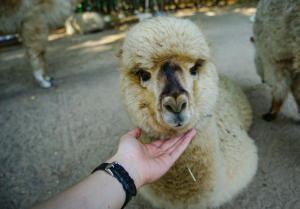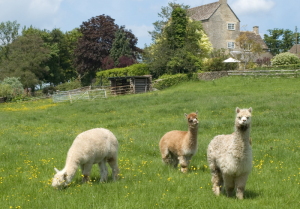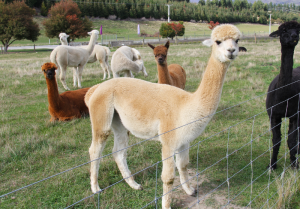Can You Ride Alpacas?
Alpacas are animals that originate from South America. They are closely related to llamas and camels but are often smaller in stature. Alpacas are a petting zoo staple due to their friendly, calm demeanor and patience around younger children. However, given their relation to other camelids, you may be wondering if alpacas are rideable.
Can you ride alpacas? Due to their small stature, alpacas should not be ridden. Alpacas are too small to support the weight of a fully grown human and should not be ridden under any circumstances. While you may think to put a small child on them, this too can be dangerous because the alpaca can become spooked by weight being placed on their back.
Though this answers your initial question, you may still have additional questions, such as why camels and llamas are safe to ride but alpacas are not. Or, what the physical differences between these closely related species actually are. I’ll answer all your questions and more as we dive into everything you need to know about riding, and not riding, alpacas.
Are Alpacas Safe for Children to Ride? 
Now that you know why alpacas cannot be ridden by full-grown adults let’s discuss why it is safe for children to ride them. Alpacas have a very docile temperament which makes them excellent animals to keep around children. They are friendly, curious, and social, meaning they like to get acquainted with new humans, including the little ones.
Alpacas are traditionally herd animals, which means they need a flock of other alpacas in order to be happy. Their social nature translates to humans as well; they enjoy being pet and shown affection by us. This is why they make wonderful additions to petting zoos, as well. Their serene mannerisms and smaller size make them great around younger children.
So, to answer the question, is it safe for children under three to ride alpacas: Yes! It absolutely is. It may take some training for the alpaca to get comfortable carrying around a child on its back, but due to their easy-going temperament, riding an alpaca can be safe for young children when supervised by an adult.
Why Adults Shouldn’t Ride Alpacas
The main reason that it is unsafe for adults to ride an alpaca is its small size. Adult humans, depending on the individual, of course, can weigh an average of one hundred and two hundred and fifty pounds. Alpacas, on the other hand, only weigh between one hundred and ten to two hundred pounds when they are fully developed.
This does not make them large enough to support the weight of an individual who’s actually heavier than they are! In addition to this, alpacas tend to measure about two to three feet tall, making them relatively short and skinny.
On top of their physical attributes, like weight and height, the bone structure of an alpaca is thin and not strong enough to support a human. Their leg bones are skinny in nature and, even with four of them, are not sturdy enough to support an adult.
Animals Other Than Alpacas You Can Ride
Maybe you’re a fully grown adult who is feeling disappointed that you’ll never be able to ride an alpaca. Don’t worry! There are plenty of other animals, besides horses, that are safe for adults to ride. Just a disclaimer, I will be focusing on animals that can give you a similar experience to riding an alpaca as opposed to random zoo animals.
You Can Safely Ride Camels
Both camels and alpacas belong to the Camelidae classification of animals. This type of animal is characterized by its tall legs and slender neck. These attributes are found in both camels and alpacas. They are both herbivores, meaning they consume only plant matter.
Though they share many of the same generic physical attributes, camels and alpacas differ in some pretty important ways. For example, camels are a lot bigger than alpacas. Camels usually measure about six feet in height and can weigh over one thousand pounds! This makes them on par with horses in size, meaning they can definitely support the weight of a fully-grown adult.
Camels can serve as an excellent means of transportation for desert travel as they can actually outrun horses on sandy terrain. As you might already know, camels can also store water in their humps, meaning they can go for long periods of time without needing to stop for a water break. Between their ability to carry water and their gritty demeanor, camels can make hardy traveling companions.
Where Can I Ride Camels?
Due to their chosen environment being the desert, camels can be hard to come by in the United States. But not to worry! On your next trip to Las Vegas, you can stay at this awesome Camel Ranch. There are yurts available for a “glamping-esque” experience, as well as camel rides for those who would rather stay on the strip.
While you’re not likely to find camels at just any petting zoo, if you’re really determined to ride a camel, there are certainly ways to make it happen. You’ve just got to do a little research. Camels are probably the closest you can come to experiencing what it would be like to ride an alpaca, given that they come from the same family of animals.
You Can Safely Ride Ostriches
While camels were bred to be ridden by humans, ostriches are not. In fact, ostriches aren’t even mammals, they are officially classified as avian creatures, aka birds. They lay eggs to reproduce; however, unlike most birds, they cannot fly. This is why they make excellent riding companions!
Ostriches can be more unpredictable in their demeanor than camels or alpacas. Sometimes, male ostriches will even become aggressive or territorial over certain areas, acting out in violence towards humans. Though, with proper training and practice, ostriches can be safe for adults to ride.
They originate from Africa, and this is the only area where they are still natively found today. As with camels, you definitely won’t be able to ride an ostrich at your local petting zoo, but with proper research, anything is possible.
While ostriches can technically support the weight of a fully grown human, riding them does represent a morally gray area. Oftentimes, the only place to ride an ostrich is at a specialty tourist attraction.
While ostriches can support one human’s weight, over time, their bones take damage from the continued weight of human riders. They can suffer from pain or joint problems if they are used as lifelong tourist attractions. Before you fork over your hard-earned money for a novelty ostrich ride, just be sure that the establishment you’re at is ethical and treats its ostriches with care.
Reasons To Own An Alpaca Other Than For Riding 
While adults might not be able to ride alpacas, there are still a plethora of reasons you might consider owning one.
For starters, alpacas produce warm, hypoallergenic fleece that can be sheared off of them (painlessly) once a year. The process of shearing, though it may be stressful for some of the more sensitive alpacas, does not harm them in any way and is actually necessary for their health and wellbeing.
Alpaca fleece has many uses. First off, it can be used to make clothing items, like sweaters and scarves. The advantage of using alpaca fleece over other kinds of fleece or wool, like sheep wool, is that it is hypoallergenic and has natural water-wicking abilities.
What is the difference between water-wicking and waterproofing? Well, waterproof is when a fabric completely repels water. It doesn’t get wet in the slightest because the water that falls onto it is unable to penetrate the fibers of the fabric. Water-wicking is when the fibers of a fabric naturally transfer moisture to the top. This means that some water still is able to penetrate the fibers and seep into the crevices of the fabric.
However, with alpaca fleece, the fibers are so naturally thick that water is unable to soak through. So, basically, the fabric wicks away a majority of the moisture to keep you dry!
In addition to the high-quality fleece they produce, alpacas make wonderful pets. There is a reason they are often found in petting zoos, after all! As I’ve previously described, alpacas are social animals who adore attention from humans and other alpacas alike. They are curious and friendly, as well as affectionate. If you’re looking to learn more about alpaca behaviors, such as how they show affection, check out my Alpaca Behavior Guide.
In addition to providing their owners with companionship, they are entertaining to watch play and relatively easy to care for. Due to their smaller size, they need less space than larger animals, like horses, and can generally care for themselves given adequate food and attention.
Finally, alpacas are intelligent creatures! They can easily be trained and respond to their names quite quickly with proper repetition. With repeated exposure and time, they will learn to love you, leading to a strong bond between you and your alpacas to develop.
You can learn more about alpacas and other homestead animals in my latest articles here!

